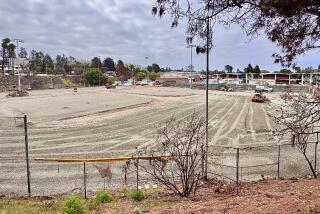Santa Monica High Overhaul on Way
- Share via
SANTA MONICA — The roof leaks. Tiles fall from the ceiling, sometimes while a class is in progress. Electric outlets don’t work. The heating system is substandard. The whole place needs paint.
Santa Monica High School science teacher Greg Runyon is too diplomatic to say the school is falling apart, but he acknowledges that the deficiencies are many.
“We have rooms where the rugs are literally shredded,” he said. “That’s not a pleasant environment to teach in. It’s sort of depressing.”
But help is around the corner for Runyon, his colleagues and the 2,563 students who attend classes at the crumbling collection of buildings on the 31-acre site at Pico Boulevard and 7th Street.
The Santa Monica-Malibu Unified School District Board of Education has approved preliminary plans for a major renovation of the 80-year-old campus. At its Jan. 28 meeting, the board endorsed a $24.8-million renovation plan that calls for a top-to-bottom overhaul.
The money will come from a $75-million bond measure for capital improvements approved by Santa Monica-Malibu voters in 1990.
Included in the renovation plan are extensive improvements in the plumbing, electrical and heating systems, roof repairs and construction of elevators and ramps to make the campus more accessible to people with disabilities. Classrooms--built when class size was little more than the age of a typical high school student--will be enlarged.
Other projects include expansion of parking facilities, addition of a second floor to the administration building and creation of a clearly defined school entrance.
Like many other visitors, the architects who drew the plan couldn’t find the entrance when they first visited the campus, said Bill Bonozo, facilities improvements director for the district.
“They drove around the school a couple times,” he said.
Several elements of the plan remain up in the air. There is debate, for example, about whether to include a $34,950 health center or a $42,600 child-care center in the renovation.
Runyon, who served as chairman of the committee that helped shape the plan, said most committee members support the centers in theory but do not believe bond money should be used to pay for them.
Another concern is that the centers will displace educational programs, he said.
The school board voted in January, 1991, to establish a health care center on the high school campus. But board member Michael Hill, an outspoken supporter of the clinic, said it was always assumed that the clinic would not be built until outside funding, most likely from a private foundation, was found to pay for it.
The board never authorized spending bond money for a health center, and Hill said he personally opposes such a move.
“As desirable as a health clinic is, it is not as desirable as our music program or our athletic program. We are an educational institution.”
The renovation is to take place in five phases, with work on the first phase to start as early as June if everything goes well, Bonozo said. More suggestions from the community will be gathered at a meeting Feb. 17 at 7 p.m. in the high school cafeteria. The final phase may be completed as early as 1996, Bonozo said.
The first phase targets the science and technology buildings. Some portable classrooms will be used during construction, Bonozo said.
District officials have tried to keep the renovation plans flexible, in part because the high school is now putting together a restructuring plan designed to improve the way education is delivered. The renovations therefore call for a mix of classroom sizes to accommodate anticipated changes in programs and teaching methods.
But rather than wait for completion of the restructuring plan, Bonozo said, district officials decided to press ahead with the renovation to take advantage of low construction costs during the recession.
Much of the renovation work is simply a matter of catching up with decades of deferred maintenance. School board member Patricia Hoffman, who served on Runyon’s committee, said routine maintenance projects have been routinely deferred for the last 35 years because of tight state funding for education.
The district maintains a list of badly needed repairs it cannot afford. At times, the project waiting list has topped $20 million, according to Art Cohen, assistant superintendent of finance and business services.
“That’s why we went for the bond,” he said. “We knew there would never be enough current revenue available either locally or from the state to correct all the maintenance work that was required to be done by the district.”
The bond money will allow the district to repair all of its facilities “in one fell swoop,” Hoffman said.
“We will have a high school that aids education rather than hinders education,” she said. “We’ll have a place where we can show students and teachers how important they are rather than have a campus that I think in some ways hinders that message.”
More to Read
Sign up for Essential California
The most important California stories and recommendations in your inbox every morning.
You may occasionally receive promotional content from the Los Angeles Times.













